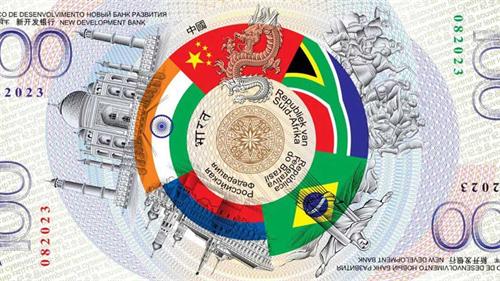BRICS Currency Experiment: Viable Dollar Alternative or Pipe Dream?

For decades, the U.S. dollar has dominated the global trade settlement system. Countries have "habitually" relied on it for cross-border transactions—not entirely by choice, but more as a matter of passive acceptance. The dollar's status as the global “hard currency” is supported not only by the size of the U.S. economy and its military power, but also by the global practice of pricing oil and commodities in dollars. However, as geopolitical dynamics shift and U.S. policy becomes more unpredictable, more countries are beginning to question this system.
The Hidden Costs of Dollar Dominance
The U.S. monetary policy cycle directly impacts the global economy. When the Federal Reserve raises interest rates, international capital flows back to the U.S., triggering capital flight, currency depreciation, and rising debt costs in other countries. Conversely, rate cuts and quantitative easing often flood the world with dollars, exporting inflation risks globally. For many developing nations, the sense of being “harvested” by this system is growing stronger. It’s no surprise, then, that calls for “de-dollarization” have grown louder in recent years.
The BRICS Challenge: Dethroning the Dollar
Since 2009, the BRICS nations have explored building a more diversified international monetary system. The Russia-Ukraine conflict and subsequent Western financial sanctions on Russia only underscored the dangers of excessive dependence on the dollar. These events have pushed the BRICS countries to seriously consider alternative paths that avoid the Western-dominated financial networks.
In January 2025, the BRICS bloc expanded into a ten-member alliance—adding Egypt, Ethiopia, Iran, the UAE, and Saudi Arabia. In a high-level summit, the concept of a “new cross-border settlement currency” was made a core agenda item. This so-called “BRICS currency” is not meant to replace national currencies or fully confront the dollar. Rather, it is envisioned as a tool for intra-BRICS trade, allowing members to bypass dollar settlements and reduce exposure to U.S. sanctions.
Yet the idea quickly met external resistance. Shortly after the summit, U.S. President Donald Trump posted a harsh message on social media, accusing the BRICS nations of "collectively challenging the American economic order" and threatening 100% tariffs on their exports. Clearly, the U.S. still has the policy tools to suppress de-dollarization efforts. Ironically, though, such pressure only reinforces other countries' perception that finding alternatives is not just an economic decision, but a matter of national sovereignty.
The Return of Gold: Both Hedge and Symbol
In searching for alternatives to the dollar, BRICS countries have increasingly turned to gold. With its intrinsic value and immunity to the monetary policies of any single country, gold is seen as a safe haven. Since 2022, the BRICS bloc has become the world's largest official buyer of gold. By mid-2025, the group’s total reserves had reached 6,300 tons and continued to grow. In June 2024, India significantly boosted its gold reserves by acquiring more than 9 tons, reflecting a clear move toward diversifying away from the U.S. dollar. Meanwhile, the United States continues to hold over 8,000 tons of gold—the world’s largest reserve—but this amount has remained virtually static for many years.
Gold’s comeback isn’t just about hedging—it also carries symbolic meaning. It reflects a broader reevaluation of the fiat currency system’s credibility. In designing a new settlement currency, the BRICS countries have discussed using gold as a partial anchor to enhance its credibility and acceptance. However, we’re still far from the ideal of a gold-based dollar replacement.
The Gap Between Vision and Reality
Although BRICS leaders have voiced ambitious goals, actual advancements in areas like currency swap agreements, trade settlement in local currencies, and the development of financial infrastructure have been modest and incremental. According to the Bank for International Settlements, intra-BRICS trade settled in local currencies still accounts for less than 5% of total trade—showing that local currency settlement is still in its infancy. In key areas like commodity pricing, cross-border investment, and financial services, the dollar's dominance remains deeply entrenched.
One major hurdle is the economic and financial disparity among BRICS members. From India, with a per capita GDP below $3,000, to China, Russia, and Brazil as upper-middle-income economies, to resource-dependent Saudi Arabia and South Africa, the bloc has divergent inflation rates, interest rate policies, and exchange rate systems. These differences pose significant challenges to building a unified currency or common settlement system.
Technology is another barrier. Most global financial transactions rely on the U.S.-dominated SWIFT network. The "BRICS Pay" initiative, intended to facilitate cross-border transactions among member states, remains in its developmental phase and has yet to see widespread implementation. Even if cross-border payment interoperability is achieved, a strong and unified clearing, custody, and compliance infrastructure is essential to make true de-dollarization feasible.
The Dollar’s Real Power: Not Just Currency, But Systemic Control
The dollar’s longstanding supremacy stems not just from the strength of the U.S. economy. It is backed by a comprehensive global political, military, technological, and institutional system. From commanding the world’s most powerful military, to leading high-tech global supply chains, to controlling key financial institutions like the IMF and World Bank, the U.S. has built a massive financial empire. Within this empire, the dollar serves as the "admission ticket," allowing the U.S. to steer global economic trends.
This network has created a formidable “dollar moat”—encompassing SWIFT, U.S.-based clearing houses, credit rating agencies, and the liquidity of global bond markets. Any challenger must invest immense resources to reconstruct an alternative system—not just issue a new currency.
The Gap Between Aspiration and Execution
The BRICS ambition to reduce dollar reliance is understandable and reflects valid concerns about the inequities of a unipolar currency world. But from an operational perspective, the “BRICS currency” appears more like a long-term strategic vision than a policy tool ready for implementation. Challenges around gold reserves, payment infrastructure, policy coordination, and international legitimacy all remain daunting.
If de-dollarization is a slow but inevitable process of global evolution, then the BRICS currency experiment is better seen as an exploration and a signal—a declaration of intent for financial restructuring in a multipolar world. Whether it will truly become a viable dollar alternative remains uncertain. But to call it a pipe dream may be premature.



